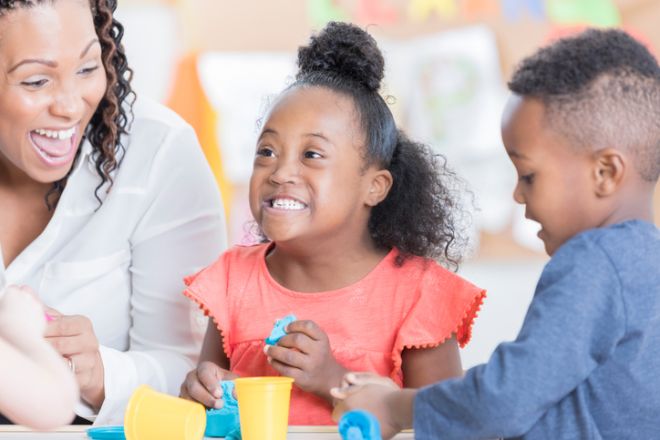
Source: SDI Productions / Getty
MADAMENOIRE has got your guide to navigating your child’s first year of school. From the first day drop-off to celebrating milestones along the way, your little one is ready for an exciting new adventure. Your baby is all grown up and ready to mingle. They’re walking, talking, and eager to spread their wings.
So gather your to-do list and just have fun with it. By knowing what to expect and planning ahead, you will lay the foundation for a great year as you and your child embark on this journey together.
Benefits of preschool
Studies show that investing in early childhood education provides long-term benefits, including higher test scores and high school graduation rates, according to a 2015 cost-benefit analysis of universal pre-K.
Not all pre-K programs are created equal, however. The process of finding the right school for your child will vary based on your location. While a handful of states have made strides in providing access to early childhood education, finding a quality program is far from guaranteed in the U.S. overall. Check out NIEER’s (National Institute for Early Education Research) latest State of Preschool report for a thorough breakdown of preschool access state by state.
With summer in full swing, your child’s first day of school is just around the corner. It’s time for your precious mini-me to embark on a new adventure. Starting school is a big adjustment and change is often challenging (yet rewarding). Knowing what to expect and preparing ahead will ensure a smooth transition.
Here’s what every parent should know as their child enters their first year of school.

Source: AzmanJaka / Getty
1. Finding the right school for your child
If you are in a position to be able to choose your ideal preschool for your child, here are some factors to consider in the vetting process:
Teacher-to-student ratio
A balanced teacher-to-student ratio is a fundamental trait of a quality preschool education. The ideal ratio is 1 to 10 or better, according to NIEER. As parents, we can imagine why this would enhance the quality of your child’s experience. The research suggests that in this environment, “teachers provide more stimulating, responsive, warm and supportive interactions” in addition to “more individualized attention.”
Diversity
A diverse classroom and curriculum are not a given. But this can make or break a family’s decision to choose a preschool. Early childhood education expert Dr. Maureen Nicol gathered insights from a diverse group of Black parents across the U.S. to find out what they are looking for in a quality preschool.
“It became clear that Black parents feel the need to take extra consideration(s) when selecting child care because of the implicit and cultural biases Black children and Black families experience in childcare and American schooling,” Dr. Nicol wrote for Parents.
Overall environment
What is the overall environment of the school? Schedule a tour. This will allow you to get a sense of the staff, students, facilities, and more. This is your chance to ask about classroom size, teacher-to-student ratio, and curriculum. As Dr. Nicol suggests, this is your opportunity to assess the cultural representation of staff and students. Are there staff and students that look like you and your child? Will your child be exposed to diverse cultures or is the school lacking in diversity?
Affordability
Those without access to universal pre-K may be forced to consider paying for private preschool. However, if paying tuition is not a realistic option for your budget, there are a few avenues to consider, according to Dr. Nicol.
One is researching your city or state’s child care assistance or financial aid options. These may be able to fund daycare or other child care.
Your child may qualify for Head Start, a federal program that funds early childhood education for families in need of financial assistance. Find out if your family is eligible by contacting the preschool directly.
Ask the learning center or preschool you are vetting if they offer financial aid or scholarships. If they do not, ask them to refer you to a provider who can offer financial assistance for your child’s education.
2. Your child’s first day of school
The day has arrived. Your child is ready to go—backpack on and a fresh outfit for a quick photo shoot before you say goodbye. You may or may not shed a tear. But once you hand them off, you can breathe a sigh of relief. You made it. Now go and enjoy some well-deserved “you” time.
Here are some first day of pre-K staples :
School supplies
Your school will provide a list of supplies to bring during the first day or week of school. Pre-K students will need a backpack that is large enough to fit a standard school folder for sending home notices.
Packed lunch or snack
Your child will need a lunch or snack to enjoy during mealtime. Start with something simple and familiar and pack it in a fun lunch bag. Some schools offer free meals, so check with your school if you are interested in this option. And don’t forget a leak-proof water bottle to keep your child hydrated throughout the day.
Bedding for nap time
Your school may ask you to provide a blanket or a nap mat for nap time. Choose a design or style that is fun and familiar so your child can feel comfortable settling down for a snooze in a new environment. My child, on the other hand, refused to nap for the entirety of his year in pre-K, so he had “quiet time” instead. Some children might prefer this over a nap. They can read, draw or work on a puzzle.
3. Tracking your child’s milestones
If you’re a busy parent, the school year can easily become a whirlwind. Next thing you know, it will be time for your little one to start kindergarten. By knowing what to expect, you will be better prepared to navigate your child’s first year.
Teacher-parent partnership
Speaking with your child’s teacher(s) and getting on the same page can help both parties provide the best support for your child. I was encouraged from day one to reach out to my son’s preschool with any questions or concerns. Having this line of open communication with the school put me at ease as a new parent. Many schools use the Class Dojo app to provide updates, share photos and message parents directly, making communication even easier.
Preserving their first masterpieces
Your child will be painting, drawing, gluing, and coloring all year long. With all of the various art projects your child will bring home over the year, you will have plenty of artwork to adorn your fridge. These can pile up quickly if you don’t have a game plan. One fantastic option for preserving your child’s first masterpieces is to put them in a book that you can treasure forever without having to keep the originals. Check out this DIY guide on how to create your own art book.
4. Volunteer opportunities for parents
Your school may offer parents opportunities to get involved with the school. At my son’s school, it was called the PAC or Parent Advisory Committee. As a member, you will take part in decision-making about events, fundraisers and more. This is also an opportunity to get to know other parents at your child’s school.
5. What your child eats in school
Figuring out what your child should eat in school can be especially puzzling for parents of children with discerning palates. Now is the time to be flexible. If your picky eater prefers to snack instead of having a full meal in school, there are plenty of nutritious and tasty options to choose from that will keep their bellies full.
It’s easier than ever to find healthy snacks in your local supermarket. Or if you want to save some money, you can prepare healthy snacks at home. Some easy and balanced snack options include veggie-based chips, sticks or puffs; cereal (our favorite is Honey Nut Cheerios); fruit leather, cheese and crackers; or snack bars (KIND and CLIF make kid-friendly granola bars).
Add a side of fruit to add a fresh element to your child’s snack or lunch. My 4-year-old’s go-to fruit snack is sliced strawberries. Your school may prohibit certain snack items like nuts, so check with your school before planning snacks or lunches for your child.
Final Thoughts
As the year progresses, you will watch as your child becomes more independent, confident and capable before your eyes. Their confidence will grow as they learn new skills and build relationships with their peers. Before you know it, it will be time to start thinking about kindergarten. Enjoy every moment!









